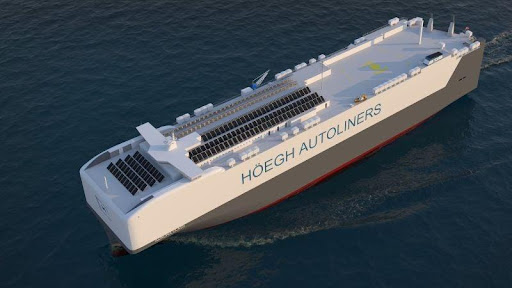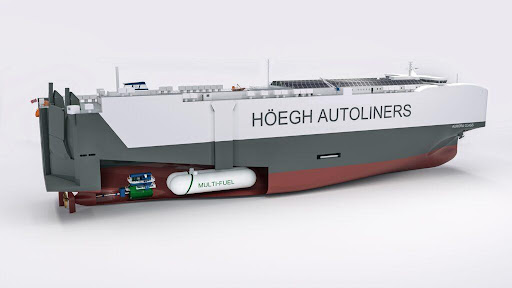Vehicle manufactures seek green supply chains.
As a Volvo owner and enthusiast of many years, I noted the recent headline “Volvo shifts to renewable fuels for ocean freight”. The article went on to explain that every year tens of thousands of containers of production material destined for Volvo factories are carried across the world’s oceans on container ships. In the future, most of these voyages are to be executed using renewable fuel instead of traditional fossil fuel. In so doing the company aims to achieve an immediate reduction in fossil fuel CO2 emissions from ocean freight of 55,000 tons over a year and spark increased demand for carbon-efficient ocean transportation.
Since 2010, Volvo has been owned by Zhejiang Geely Holding Group which also owns 15 other vehicle manufacturers. The shift to renewable fuels in ocean freight is being undertaken in cooperation with logistics partners Maersk, Kuehne+Nagel and DB Schenker, which have from 1 June 2023 switched to renewable fuel for their transportation needs. For its part, Volvo has committed to becoming climate neutral by 2040.
More than 90% of new auto carriers on order today are designed to run on LNG or alternative low or zero emission fuels. The new Aurora class of car carriers ordered by Höegh Autoliners. from China Merchants Heavy Industry Jiangsu, offer an example of the technologies being piled into this segment of shipping in an effort to meet both their own emission targets and those of their customers. The 8 x 9,100 car equivalent units (CEU) capacity vessels are to be fitted with a multi-fuel engine that can operate on marine gas oil (MGO) and liquefied natural gas (LNG), however the vessels will also carry the DNV methanol and ammonia ready notation. The first two vessels in class will be delivered in the second half of 2024.
In May this year, Höegh announced a partnership with Norwegian green energy provider North Ammonia for the supply, distribution, delivery and consumption of green ammonia, a carbon free fuel produced using renewable energy. The partnership is intended to enable Höegh Autoliners to fuel at least 5% of the company’s fleet with green ammonia by 2030. North Ammonia was established by the Grieg Maritime Group and Arendals Fossekompani in 2021 with a viewing to making green ammonia scalable for use in the marine sector. The Port of Arendal will host the production and storage facilities with Grieg Maritime developing a North European bunkering infrastructure.
 Courtesy Hoegh Autoliners – Aurora class artist’s impression
Courtesy Hoegh Autoliners – Aurora class artist’s impression
The Aurora class will be notated as Class +1A, Car Carrier, MCDK, ICE C, E0, NAUT-OC, CLEAN DESIGN, BWM-T, TMON, BIS, COAT PSPC (B), GAS FUELLED, BATTERY (safety), F(C), Recyclable, SHORE POWER, Gas ready Ammonia (D, S, MEc, T) and is expected to be the first class of auto carriers to be ready to run on carbon neutral ammonia.
On a side note, the 2023 IMO Strategy on Reduction of GHG Emissions from Ships, with enhanced targets to tackle harmful emissions, was adopted on Friday July 7 on conclusion of a meeting of the Marine Environment Protection Committee (MEPC 80) in London. The revised IMO GHG Strategy aims to achieve net-zero GHG emissions from international shipping “close to 2050”, with a commitment to adopt alternative zero and near-zero GHG fuels by 2030 and introduces indicative check points for 2030 and 2040.
In summary:
- The carbon intensity of shipping is to decline through further improvement of the energy efficiency for new ships.
- The carbon intensity of international shipping is to decline as an average by at least 40% by 2030, compared to 2008.
- The uptake of zero or near-zero GHG emission technologies, fuels and/or energy sources to increase the uptake of zero or near-zero GHG emission technologies, fuels and/or energy sources to represent at least 5%, striving for 10% of the energy used by international shipping by 2030.
- GHG emissions from international shipping are to peak as soon as possible and reach net-zero close to 2050, taking into account different national circumstances, whilst pursuing efforts towards phasing them out as called for in the Vision consistent with the long-term temperature goal set out in Article 2 of the Paris Agreement.
The agreed indicative checkpoints to reach net-zero GHG emissions from international shipping were:
- To reduce the total annual GHG emissions from international shipping by at least 20%, striving for 30%, by 2030, compared to 2008.
- Reduce the total annual GHG emissions from international shipping by at least 70%, striving for 80%, by 2040, compared to 2008.
- The take away from MEPC 80 is that the shipping industry is far ahead of the IMO in terms of the objective time line to reach net-zero GHG emissions.
Featured Image Courtesy: Hoegh Autoliners – Aurora class artist’s impression

